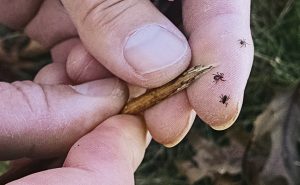As the myriad collections of colorful leaves paint our local landscapes, it’s important to remember that once on the ground, these leaves present the perfect habitat for the emerging population of adult deer ticks (Ixodes scapularis, also known as the black-legged tick). Leaves provide a moist and high-humidity environment that is essential to deer tick survival. While nymph ticks are at their peak during the spring and summer months, and are responsible for transmitting the most cases of Lyme disease to humans, the fall months are optimal for adult deer ticks encountering companion animals, resulting in the highest seasonal incidence reports of canine Lyme.
- Photo: Bob Maurais
- Ticks are not only problematic to humans, but dogs and cats. Photo: Bob Maurais
Companion animals are sentinels for ticks. Our technicians educate our customers on how, if there are ticks on or about their property, their pets are likely to be the first to interface with them. And if pets are picking up ticks, humans are more likely to encounter them as well.
Ticks are not only disgusting, but also a serious health threat. Tick-borne diseases (TBDs) are either endemic (established) or emerging in many parts of the United States and Canada. The months from October through February are very active times for adult deer ticks. Ticks actually prefer cooler temperatures for questing, and are active anytime the temperature rises above freezing. Although the Northeast and upper Midwest are hotbeds for Borrelia burgdorferi, the causative disease agent for tick-transmitted Lyme disease, anaplasmosis and ehrlichiosis are also prevalent in certain states (see Table 1).
| Table 1: Percentage of dogs testing positive for tick-borne disease* | |||
| State | Lyme | Ehrlichiosis | Anaplasmosis |
|---|---|---|---|
| Maine | 13.88% (1 in 8) | 1.58% (1 in 64) | 12.4% (1 in 9) |
| Connecticut | 16.84% (1 in 6) | 1.63% (1 in 63) | 17.61% (1 in 6) |
| Missouri | 0.34% (1 in 295) | 10.29% (1 in 10) | 0.31% (1 in 255) |
| Arkansas | 0.23% (1 in 428) | 18.95% (1 in 6) | 0.39% (1 in 255) |
| SOURCE: Companion Animal Parasite Council | CAPCVet.org * As reported by veterinarians through August 2017 |
|||
Deer ticks, prevalent in many parts of the Northeast and upper Midwest, are now expanding south, whereas the predominantly Southern-dwelling Lone Star tick (Amblyomma americanum, aka the turkey tick), is moving northward. Although Lyme disease gets headlines and the majority of attention, other disease agents also pose a serious and ongoing threat to public health.
What you can do
Pest management professionals play an important role in educating customers about tick-borne diseases. Tick education should be an integral part of your communications. TBDs are a serious and growing concern on neighborhood and community levels, as well as regionally and nationally. Consider the following:
- Use educational literature that is current and sourced.
- Obtain real-time data and mapping to understand and depict the changing risk as the season wears on. Resources for this include your state and local public health agencies, the U.S. Centers for Disease Control and Prevention, and the Companion Animal Parasite Council.
- Acknowledge that trends for future tick encounters and resulting tick-borne diseases are increasing. Your educational efforts must be commensurate to the threat.
- Define and avoid high risk areas for people and pets.
- Anticipate a spring tick bloom for Lone Star ticks, and a fall bloom for adult deer ticks.
- Implement the appropriate tick strategies and recommendations for people and pets, including personal protection strategies, veterinarian-provided topical or systemic options, landscape modifications, and properly timed area treatments.
Love your customers, love their petsKeep in mind that the tick landscape is constantly changing, increasing the prevalence and incursion of new diseases. Stay a step ahead of your customers with new information.
Because ticks transmit a wide variety of disease agents to people and pets while being active throughout the year, tick control must be practiced consistently. Prevention is the best prescription.
Uptick in ticks
Why are there more documented tick encounters today? Probable reasons include:
- Proximity — the ever-increasing overlap of residential developments into tick habitat.
- Landscapes often defined by areas with abundant edge interspersion (interface of lawns and wooded edges).
- A change in the environment.
- Land use in work and recreation.
- A change in wildlife habitat.
- Healthy deer population-reforestation provides for plentiful browse for deer.
- Plentiful rodent population.
- Habitat for predators diminished with new developments.
- Shift in abiotic factors (climate, temperature and humidity).
- Pet owners are more vigilant than ever.
[Editor’s Note: Check out this podcast on ticks.]
Bob Maurais is president of Mainely Ticks, based in Wells, Maine. He may be reached at bob@mainelyticks.com.




Leave A Comment